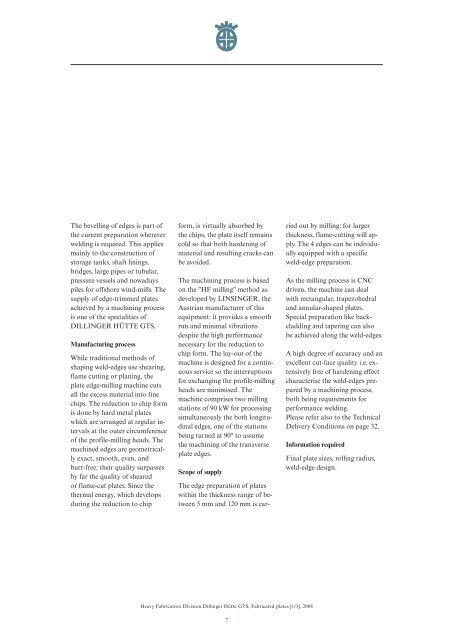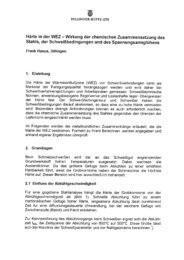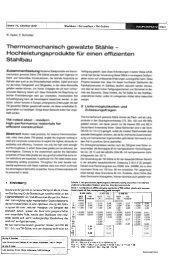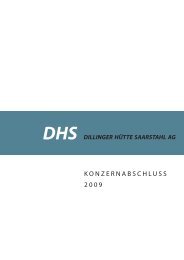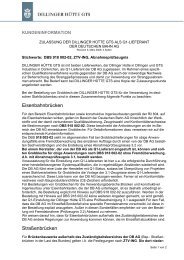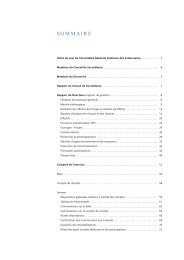Delivery program "Heavy Fabrication Division" - Dillinger Hütte GTS
Delivery program "Heavy Fabrication Division" - Dillinger Hütte GTS
Delivery program "Heavy Fabrication Division" - Dillinger Hütte GTS
You also want an ePaper? Increase the reach of your titles
YUMPU automatically turns print PDFs into web optimized ePapers that Google loves.
The bevelling of edges is part of<br />
the current preparation wherever<br />
welding is required. This applies<br />
mainly to the construction of<br />
storage tanks, shaft linings,<br />
bridges, large pipes or tubular,<br />
pressure vessels and nowadays<br />
piles for offshore wind-mills. The<br />
supply of edge-trimmed plates<br />
achieved by a machining process<br />
is one of the specialities of<br />
DILLINGER HÜTTE <strong>GTS</strong>.<br />
Manufacturing process<br />
While traditional methods of<br />
shaping weld-edges use shearing,<br />
flame cutting or planing, the<br />
plate edge-milling machine cuts<br />
all the excess material into fine<br />
chips. The reduction to chip form<br />
is done by hard metal plates<br />
which are arranged at regular intervals<br />
at the outer circumference<br />
of the profile-milling heads. The<br />
machined edges are geometrically<br />
exact, smooth, even, and<br />
burr-free; their quality surpasses<br />
by far the quality of sheared<br />
or flame-cut plates. Since the<br />
thermal energy, which develops<br />
during the reduction to chip<br />
form, is virtually absorbed by<br />
the chips, the plate itself remains<br />
cold so that both hardening of<br />
material and resulting cracks can<br />
be avoided.<br />
The machining process is based<br />
on the "HF milling" method as<br />
developed by LINSINGER, the<br />
Austrian manufacturer of this<br />
equipment: it provides a smooth<br />
run and minimal vibrations<br />
despite the high performance<br />
necessary for the reduction to<br />
chip form. The lay-out of the<br />
machine is designed for a continuous<br />
service so the interruptions<br />
for exchanging the profile-milling<br />
heads are minimised. The<br />
machine comprises two milling<br />
stations of 90 kW for processing<br />
simultaneously the both longitudinal<br />
edges, one of the stations<br />
being turned at 90° to assume<br />
the machining of the transverse<br />
plate edges.<br />
Scope of supply<br />
The edge preparation of plates<br />
within the thickness range of between<br />
5 mm and 120 mm is car-<br />
<strong>Heavy</strong> <strong>Fabrication</strong> Division <strong>Dillinger</strong> <strong>Hütte</strong> <strong>GTS</strong>, Fabricated plates [1/3], 2008<br />
7<br />
ried out by milling; for larger<br />
thickness, flame-cutting will apply.<br />
The 4 edges can be individually<br />
equipped with a specific<br />
weld-edge preparation.<br />
As the milling process is CNC<br />
driven, the machine can deal<br />
with rectangular, trapezohedral<br />
and annular-shaped plates.<br />
Special preparation like backcladding<br />
and tapering can also<br />
be achieved along the weld-edges.<br />
A high degree of accuracy and an<br />
excellent cut-face quality i.e. extensively<br />
free of hardening effect<br />
characterise the weld-edges prepared<br />
by a machining process,<br />
both being requirements for<br />
performance welding.<br />
Please refer also to the Technical<br />
<strong>Delivery</strong> Conditions on page 32.<br />
Information required<br />
Final plate sizes, rolling radius,<br />
weld-edge design.


